Table of Contents
Introduction to Indian buffalo breeds
India has a wealth of buffalo germplasm, including the world-renowned Murrah buffaloes- renowned for their high milk production. Aside from wild Asian buffaloes, the country hosts both river and swamp types of Asian buffaloes or Asian water buffalo Bubalus bubalis.
It is estimated (data 2017) that there are 200 million buffaloes in the world, however, 97 per cent of them reside in Asia and India. India hosts 57 per cent of the total world buffalo population amounting to approximately 109 million buffaloes. Swamp buffaloes are used for meat and draught purposes, while river buffaloes are mainly kept for milk production.
Indian economy is greatly influenced by buffaloes, as they contribute 56% of total milk production to India and also contribute in farming and some agribusinesses. Most swamp buffaloes live permanently in marshy areas, where they wallow in mud and eat coarse marsh grass. Much like various breeds of cows found in India, diverse breeds of buffalo can also be seen in India. The most popular breeds of buffalo in India are Murrah, Nili-Ravi, Jaffarabadi, Surti, Mehsana, Kundi, Nagpuri and Bhadawari.
Types of buffalo breeds in India
There are several buffalo breeds in India. Some of the buffalo breeds are mentioned below :
Banni buffalo
Banni buffalo breed is highly adapted to local climate conditions and traditional extensive methods of night grazing. Banni area’s soil is highly mineralized, saline, and sandy, with a low water holding capacity, low permeability, and prone to erosion.

Other names of Banni buffalo breed : Kundi, Kutchi
Banni buffalo Main Use : Milk
Banni buffalo Breeding Tract : Gujarat
Banni buffalo Visible Characteristics : The unique appearance of the horns, which are inverted and double/single coiled. Also vertical and upward.
Banni buffalo Origin : Around 500 years ago, the Maldharis of Banni arrived in Afganistan from Halieb with their animals in search of pasture. This buffalo breed is named after the locality of “Banni” in Kachchh district.
Banni buffalo Colour : Black also occasionally copper colour.
Banni buffalo Horns Shape and Size : Horns are heavy, medium to large in size and curved. In adult banni buffalo’s , the average size of horns is around 24-30 cm.
Banni buffalo Milk yield per lactation(kg) : 1095 – 6054 ( Average 2857.2 )
Bargur buffalo
Bargur buffalo breed is preferably rared in forest area so that it can graze in forest. The buffalo breeds are found in hamlets of bargur village A and B of Anthiyoor taluka, and Gundari and Kadamboor village of Sathyamangalam taluk.
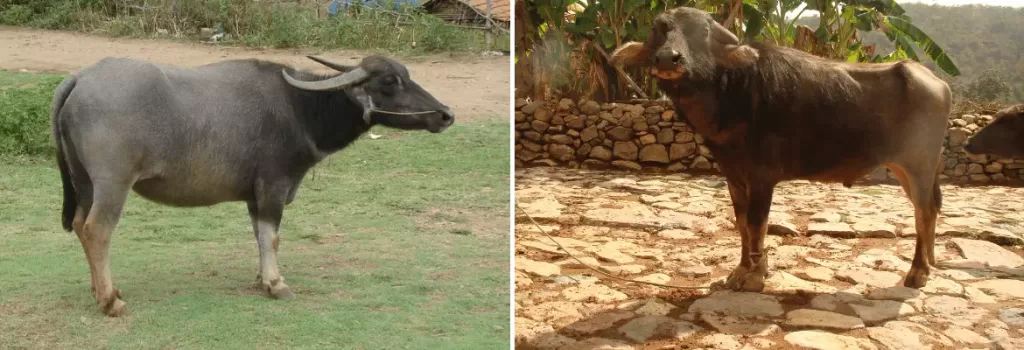
Other names of Bargur buffalo breed : Malai Emmai, Malai Erumai
Bargur buffalo Main Use : Milk, manure
Bargur buffalo Breeding Tract : Tamilnadu
Bargur buffalo Visible Characteristics : Bargur buffalo’s are medium sized cattle. The muzzels and eyelids are black and tail switch is ranges from brown to black in colour. The hoves of the bargur buffalo are black in colour. The coat colour of bargur buffalo is black or brownish black.
Bargur buffalo Origin : This buffalo breed is named after its breeding tract which is bargur hills in Anthiyoor taluk, Erode district in Tamil Nadu. The local name is malai erumai which means hills buffalo.
Bargur buffalo Colour : The colour of bargur buffalo can range from black to light brown to brownish black.
Bargur buffalo Horns Shape and Size : The horns are bent backwards and curve inwards. The horns of male burgar buffalo are medium in size and the horns of female bargur buffalo are medium to long in size.
Bargur buffalo Milk yield per lactation(kg) : -NA-
Bhadawari buffalo
Bhadawari buffalo is know for its low maintenance. It can produce milk and survive in low quality fodder and feed. Bhadawari buffalo is found in ravines of Chmbal, Yamuna and Utangan rivers of Madhya Pradesh and Uttar Pradesh. The breeding of bhadawari buffalo is done in Bah tehsil of Agra, Ambah and Porsa tehsils of Morena, Mahangaon tehsil of Bhind district and Chakarnagar and Barhpura blocks of Etawah.
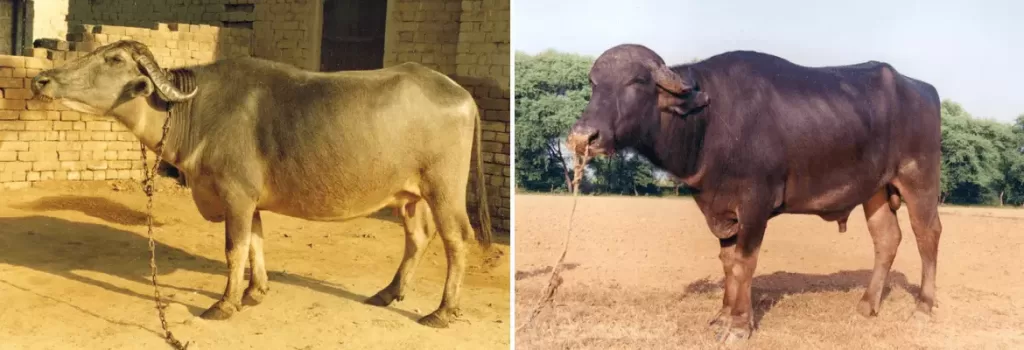
Other names of Bhadawari buffalo breed : Etawah
Bhadawari buffalo Main Use : Milk, Draught
Bhadawari buffalo Breeding Tract : Madhya Pradesh, Uttar Pradesh
Bhadawari buffalo Visible Characteristics : Bhadawari buffalo’s have a unique visible characteristic. Two white lines called as chevron also known as kanthy in local language, are visible under the neck.
Bhadawari buffalo Origin : It is believed that the bhadawari buffalo derived its name from Bhadawer state in India (before independence). Bhadauria clan rared these buffalo breeds.
Bhadawari buffalo Colour : The colour of bhadawari buffalo ranges from light copper colour to blackish copper colour.
Bhadawari buffalo Horns Shape and Size : The horns of bhadawari buffalo black in colour and they bend slightly outwards and downwards. The small to medium sized horns run parallel to the neck and slightly bend upwards just before ending in a point.
Bhadawari buffalo Milk yield per lactation(kg) : 540 – 1400 (Average 1294)
Chhattisgarhi buffalo
Chattisgarhi buffalo breed is greatly adapted to Northern hills, central plain and Bastar plateau region of Chattishgarh. They are well known for their strength and endurance and hence males of chattisgari breeds are preferred over other bullock breeds for tilling of rice fields.
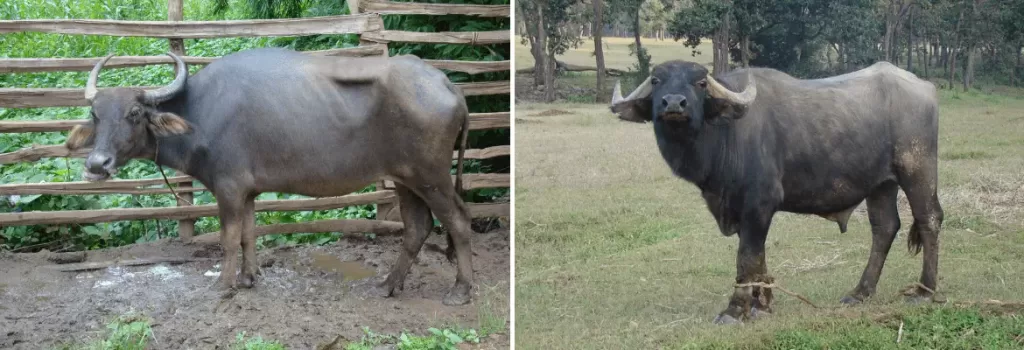
Other names of Chhattisgarhi buffalo breed : Desi
Chhattisgarhi buffalo Main Use : Milk, Draught
Chhattisgarhi buffalo Breeding Tract : Chhattisgarh
Chhattisgarhi buffalo Visible Characteristics : Chhattisgarhi buffalo has a large body structure. It has a straight head with large horns.
Chhattisgarhi buffalo Origin : These are Indigenous buffalo breeds named after the Indian state Chattisgarh.
Chhattisgarhi buffalo Colour : The colour of coat of chattishgarhi buffalo is mostly black but very occasionally grey.
Chhattisgarhi buffalo Horns Shape and Size : The horns of chattisgarhi buffalo are long. The horns bend backwards forming an arc and a little upwards just before forming a point. Average length of horns of male chattisgarhi buffalo is 46.37 cm and Average length of horns of female chattisgarhi buffalo is 51.06 cm.
Chhattisgarhi buffalo Milk yield per lactation(kg) : 1100 – 1300 (Average 1180)
Chilika buffalo
The breeding tract of Chilika buffalo is mostly saline in nature. These buffalo breeds can easily survive while feeding on aquatic vegetation or submerged weeds of saline water of Chilika lake. The local population prefers the milk and curd of Chilika buffalo breed as it is considered better in taste and has better preservation quality (curd can be preserved for almost a week). These buffalo breeds can be found in the regions like Brahmagiri, Maluda, Tangi, Bhusandapur, Satapada, Parikuda and Krishnaprasad around the Chilika lake.
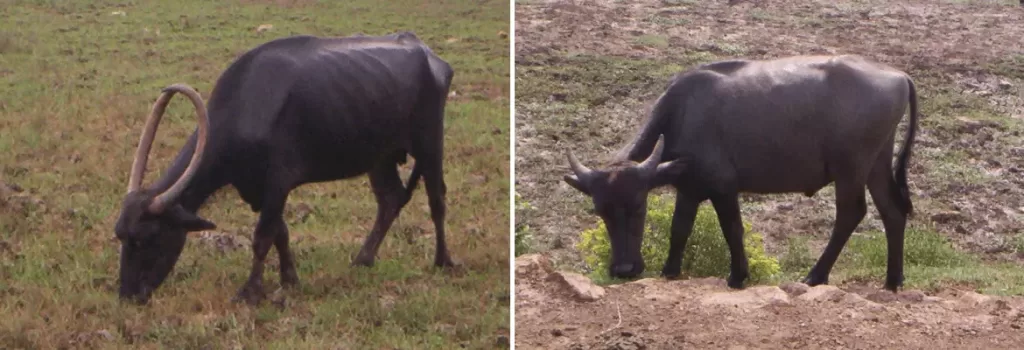
Other names of Chilika buffalo breed : Desi, Deshi
Chilika buffalo Main Use : Milk, draught, manure
Chilika buffalo Breeding Tract : Odisha
Chilika buffalo Visible Characteristics : Chilika buffalo has a comparatively small udder and small legs, which results in giving it a unique appearance of compact body and small to medium size.
Chilika buffalo Origin : These are Indigenous buffalo breeds named after the breeding tract it is found ; Chilika lake in Odisha state of India.
Chilika buffalo Colour : Black to brownish black.
Chilika buffalo Horns Shape and Size : The horns of chilika buffalo are bent upwards. Before ending in a tip, the horns further bend inwards. Average length of horns of male chilika buffalo is 48.32±0.24 cm and Average length of horns of female chilika buffalo is 50.76±0.12 cm.
Chilika buffalo Milk yield per lactation(kg) : 440 – 514 (Average 500)
Gojri buffalo
Gojri buffalo is well adapted to hilly regions and hence are often found scaling steep slopes of hills while grazing. This buffalo breed is also known for its endurance as it can travel long distances without any issue. Playing an important part in the livelihood of Gujjar community, gojri buffalo is treated as a symbol of prosperity and wealth in this community. These buffaloes are found in sub himalayan regions of northen Himachal Pradesh and Punjab.
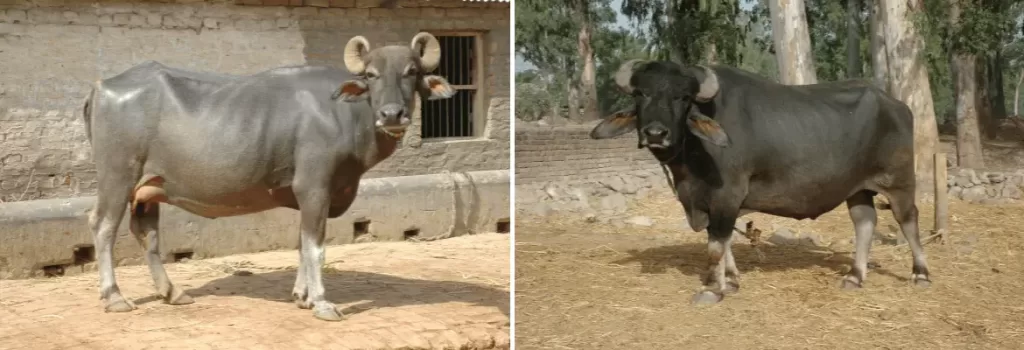
Other names of Gojri buffalo breed : Desi
Gojri buffalo Main Use : Draught, milk
Gojri buffalo Breeding Tract : Punjab, Himachal Pradesh
Gojri buffalo Visible Characteristics : Gojri buffalo has a uniquely shaped horn which forms a loop(almost a full circle). These buffaloes have a straight head.
Gojri buffalo Origin : These are Indigenous buffalo breeds named after the Gujjar community which often rares these buffaloes.
Gojri buffalo Colour : Colour of gojri buffalo can be black or brown.
Gojri buffalo Horns Shape and Size : The horns of gojri buffalo are locally called Pattih wale seengh. The horns are thick and medium sized. The horns curl outwards and then inwards forming a circular loop. Average length of horns of male gojri buffalo is 35.75 cm and Average length of horns of female gojri buffalo is 44.61 cm.
Gojri buffalo Milk yield per lactation(kg) : 800 – 1200 (Average 1000)
Jaffarabadi buffalo
Jaffarabadi buffalo is well known for its strength. It is also believed that the local community has witnessed it at times, fighting lions in the Gir forest. Rabri, Mer, Aher, and Bhadvad are the local communities which predominently rear this buffalo breed. Jaffarabadi buffalo breed is the main source of livelihood of Maldhri herdmen, providing them means of transport and milk.

Other names of Jaffarabadi buffalo breed : Gir, Bhavanagri, Jaffari
Jaffarabadi buffalo Main Use : Milk, transport, draught
Jaffarabadi buffalo Breeding Tract : Gujarat
Jaffarabadi buffalo Visible Characteristics : The unique visible characteristic of Jaffarabadi buffalo is its small eyes ( also known as study eyes), perticularly in males. The unique shape of the horns also is a very visible trait of this buffalo breed.
Jaffarabadi buffalo Origin : These are Indigenous buffalo breeds named after Jafrabad city in Amreli District, Gujrat.
Jaffarabadi buffalo Colour : Mostly black. Sometimes white of grey tail switch is also observed.
Jaffarabadi buffalo Horns Shape and Size : The horns of jaffarabadi buffalo bend downwards and then move away from the head. The horns then curve upwards and inwards towards the head or neck before ending in a point. The horns are long and often are shapped circular.
Jaffarabadi buffalo Milk yield per lactation(kg) : 2150 – 2340 (Average 2239)
Kalahandi buffalo
Much like Bhadawari buffalo, kalahandi buffalow is also a low maintenence buffalow breed. This breed can be found in Kalahandi district and adjoining areas of Rayagada district. These breeds have a heavy population in Junagarh, Kodsara, Bhawanipatna, Golamunda, and Dharmagarh area of Kalahandi district of Odisha state.
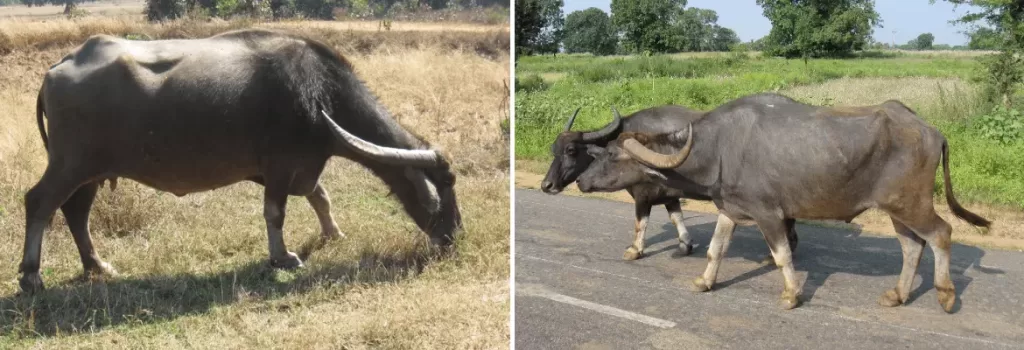
Other names of Kalahandi buffalo breed : Deshi
Kalahandi buffalo Main Use : Milk, manure, draught
Kalahandi buffalo Breeding Tract : Odisha
Kalahandi buffalo Visible Characteristics : The head of kalahandi buffalo is convex in shape. The round udder and hump are small in size. The colour of tail, eyelids, hoofs and muzzel is black.
Kalahandi buffalo Origin : These are Indigenous buffalo breeds named after the breeding tract i.e. Kalahandi district in Odisha state.
Kalahandi buffalo Colour : The coat colour of kalahandi buffalo can be grey or blackish grey.
Kalahandi buffalo Horns Shape and Size : The horns are long and can be straight or curved. They move backwards and outwards and have a slight uppish curl at the end. The average size of the horns in kalahandi buffalo is 50 cm.
Kalahandi buffalo Milk yield per lactation(kg) : 680 – 912
Luit (Swamp) buffalo
A draught breed known for its power and endurance. One of the main uses of luit buffalo is tilling of local muddy paddy cultivation fields. There are nine districts in the upper valley of the Brahmaputra river in upper Assam covered by the Luit (Swamp) buffalo. In addition to Assam, these buffaloes are also found in bordering areas Manipur, Mizoram and Nagaland.
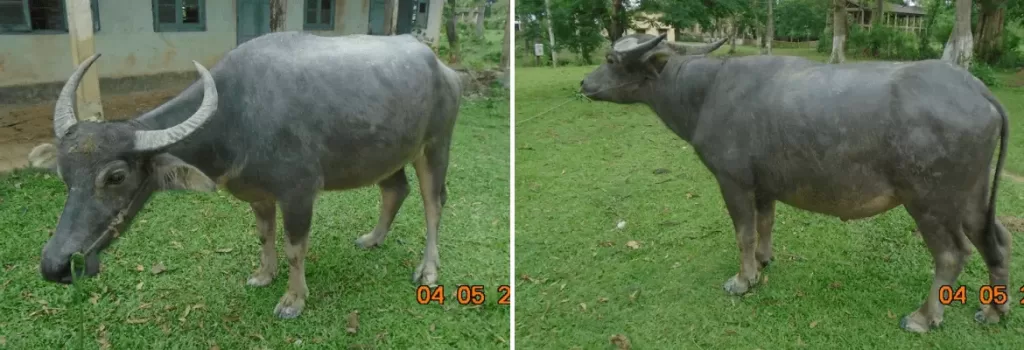
Other names of Luit (Swamp) buffalo breed : Assamese Swamp
Luit (Swamp) buffalo Main Use : Draught,Milk
Luit (Swamp) buffalo Breeding Tract : Assam
Luit (Swamp) buffalo Visible Characteristics : Medium-sized and strongly built, luit swamp buffaloes have a short tail and prominent wither. Their characteristic features are their broad, concave foreheads topped with prominent eyes, wide muzzles, and distinctive semicircular horns. Both the fore and hind legs are covered in light white stockings up to the knee.downward to the muzzle.
Luit (Swamp) buffalo Origin : These are Indigenous buffalo breeds named after the river Brahmaputra which is locally known as luit. Originaly, these swamp buffaloes were reared traditionally by the local Assamese population around the swampy areas of the river Brahmaputra.
Luit (Swamp) buffalo Colour : Black
Luit (Swamp) buffalo Horns Shape and Size : The horns of luit buffalo are curved laterally backwards and upward. The horns are shaped in a semi circular shape. Average length of horns of male luit buffalo is 60.13 cm and Average length of horns of female luit buffalo is 57.13 cm.
Luit (Swamp) buffalo Milk yield per lactation(kg) : 385 – 505 (Average 449.4)
Marathwadi buffalo
Marathwadi buffaloes breeding tract includes Parbhani, Nanded, Beed, Jalna and Latur in Maharashtra state. Milk and draught/transport purposes are both served by this breed. Cattle and buffaloes are kept together in a mixed herd in a semi-intensive management system. Sugar cane leaves/tops, sorghum, paddy straw, and grasses are common feedings.
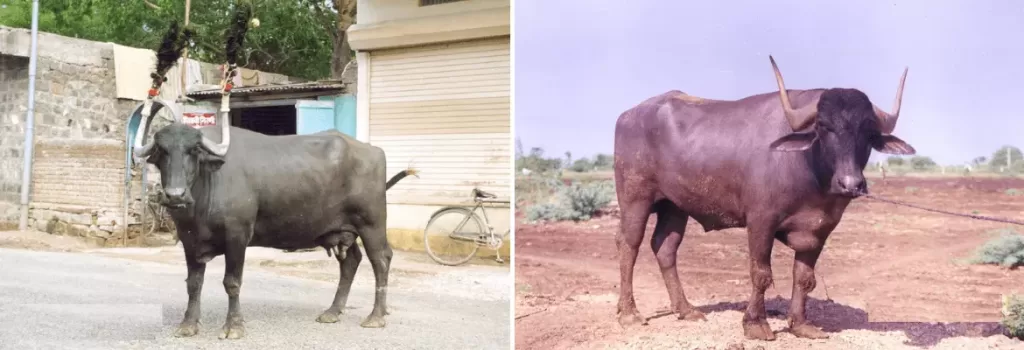
Other names of Marathwadi buffalo breed : Dudhana Thadi, Ellichpuri
Marathwadi buffalo Main Use : Milk, transport, draught
Marathwadi buffalo Breeding Tract : Maharashtra
Marathwadi buffalo Visible Characteristics : The size and the shape of the horns are a unique visible characteristics of marathwadi buffalo. Unlike pandharpuri buffalo, the horns of this buffalo reach upto the shoulder level.
Marathwadi buffalo Origin : These are Indigenous buffalo breeds named after Marathwada region in maharashtra.
Marathwadi buffalo Colour : Jet black or greyish black coat colour. White markings can be seen on the forehead and lower parts of the limbs of some buffaloes.
Marathwadi buffalo Horns Shape and Size : The horns are long and run parallel to the neck. The horns reach upto shoulder, however not crosing the shoulder blade level. The average length of horns in marathwadi buffalo is 43 cm.
Marathwadi buffalo Milk yield per lactation(kg) : 1118
Mehsana buffalo
Mehsana buffalo breed was born by cross breeding Murrah buffalo breed and Surti buffalo breed. This breed is generally populated in Kadi, Sidhpur, Radhanpura, Mehsana, Radhanpura, Patan and Kalol town in Gujarat. This breed is considered as a very good breeder and consistent milk producer.
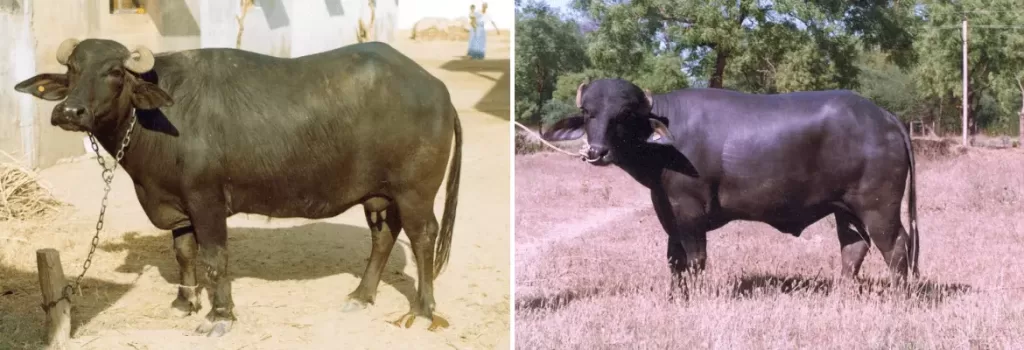
Other names of Mehsana buffalo breed : Mehsani, Mahesani
Mehsana buffalo Main Use : Milk
Mehsana buffalo Breeding Tract : Gujarat
Mehsana buffalo Visible Characteristics : One of the very visible characteristics of mehsana buffalo is its black bright eyes which seems to bulge out of its eye socket. The upper part of the eye lids have a very prominent skin folding pattern.
Mehsana buffalo Origin : These are Indigenous buffalo breeds named after a town in state of Gujarat called Mehsana.
Mehsana buffalo Colour : Black. however, occasionally brown or blackish brown.
Mehsana buffalo Horns Shape and Size : The horns curl backwards, upwards and inwards in the shape of a sickle (more as compared to Surti breed and less as compared to Murrah breed).
Mehsana buffalo Milk yield per lactation(kg) : 598 – 3597 (Average 1988)
Murrah buffalo
Murrah breed of buffalo is generally found in Bhiwani, Gurgaon, Hisar, Fatehabad, Jind, Hisar district of Delhi and Haryana. However, this breed can also be found in some parts of western Uttar Pradesh and Punjab state of India. In all parts of the world, this breed is used to grade-up nondescript buffaloes and plays a vital role in the livestock industries of many developing countries, such as Bulgaria, Philippines, Malaysia, Vietnam, Brazil, and Sri Lanka.
Male buffaloes of Murrah breed are used for both draught and breeding activities.
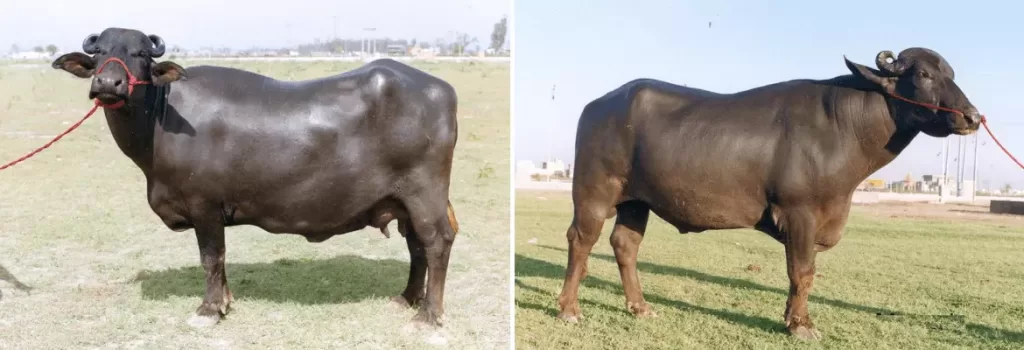
Other names of Murrah buffalo breed : Kundi, Delhi, Kali
Murrah buffalo Main Use : Milk, Draught
Murrah buffalo Breeding Tract : Delhi, Haryana
Murrah buffalo Visible Characteristics : Murrah buffalo is considerably bigger in size with broad hips. The unique curved horns (similar to Mehsana buffalo but longer) are mounted on a very big head. This buffalo breed has a ell developed udder and long neck. Occasionally, tail switch has white spotting.
Murrah buffalo Origin : These are Indian Indigenous buffalo breeds.
Murrah buffalo Colour : Dark black.
Murrah buffalo Horns Shape and Size : The horns are short and curve to form almost a circle. The horns rise upwards, backwards and then inwards ending in a point.
Murrah buffalo Milk yield per lactation(kg) : 1003 – 2057 (Average 1752)
Nagpuri buffalo
Nagpuri buffalo breed is greatly adapted to warm and hot climate of Vidarbha region. Since these buffaloes are very strong, this breed is used extensively for draught purposes. This buffalo breed has lower maintenance cost. Nagpuri buffalo is local to the Vidharba region of Maharashtra state. Akola, Amravati, Yavatmal, Wardha and Nagpur are part of the breeding tract for the nagpuri buffalo breed. One of the main purpose of rearing this breed of buffalo is for production of fat.

Other names of Nagpuri buffalo breed : Gaolavi, Puranthadi, Gangauri, Berari, Ellichpuri, Gaolaogan, Chanda, Varhadi, Arvi, Shahi, Gaorani
Nagpuri buffalo Main Use : Draught, milk
Nagpuri buffalo Breeding Tract : Maharashtra
Nagpuri buffalo Visible Characteristics : The visible characteristics of nagpuri buffalo is its typical size and shape of the horns.
Nagpuri buffalo Origin : These are Indian Indigenous buffalo breeds named after its breeding tract of Nagpur in Maharashtra state.
Nagpuri buffalo Colour : The colour of the coat is black. Presence of white spots can be seen on the face, tail tips and legs.
Nagpuri buffalo Horns Shape and Size : Long, flat, and curved, the horns bend backward and extend nearly to the shoulders on both sides of the neck with tips mostly pointing upwards. Male nagpuri buffalo has thicker and heavier horns as compared to nagpuri female buffaloes. Average length of nagpuri buffalo horn is 50-65 cm.
Nagpuri buffalo Milk yield per lactation(kg) : 760 – 1500 (Average 1039)
Nili Ravi buffalo
Nili Ravi buffaloes are native to the state of Punjab in India, between the Sutluj and Ravi rivers. This breed of buffalo can be found in Gurdaspur, Ferozepur, and Amritsar disctrict of Punjab. Nili ravi buffalo is good milker as compared to Murrah buffalo.

Other names of Nili Ravi buffalo breed : Panch Kalyani
Nili Ravi buffalo Main Use : Milk
Nili Ravi buffalo Breeding Tract : Punjab
Nili Ravi buffalo Visible Characteristics : Nili Ravi buffalo has white spotting on face, muzzle, tail, leg and forehead. They have walled eyes. A particularly striking feature of female nili ravi buffaloes is their white markings known as “Panch Kalyani”.
Nili Ravi buffalo Origin : Originally, Nili and Ravi were two different breeds, but with time and intensive crossbreeding, the two breeds were crossed and this led to the birth of Nili Ravi. The word nili is was coined to the name of the breed because of the blue waters of the river Satluj.
Nili Ravi buffalo Colour : Black.
Nili Ravi buffalo Horns Shape and Size : The horns are small in size and curl backwards almost forming a ring.
Nili Ravi buffalo Milk yield per lactation(kg) : 1586 – 1929 (Average 1850)
Pandharpuri buffalo
AMaharashtra’s breeding tract includes Solapur, Sangli, and Kolhapur districts. The local breeders in this breeding tract are Gawali and Joshi. Pandharpuri buffalo breed population can be mostly found in Pandharpur, North Solapur, South Solapur, Barshi, Akkalkot, Sangola and Mangalvedha tehsils of Solapur district; Miraj, Walwa, Jathand Tasgaon tehsils of Sangli district; and Karveer, Shirol, Panhala, Radhanagri, Hatkanangale and Gadhinglaj tehsils of Kolhapur district.
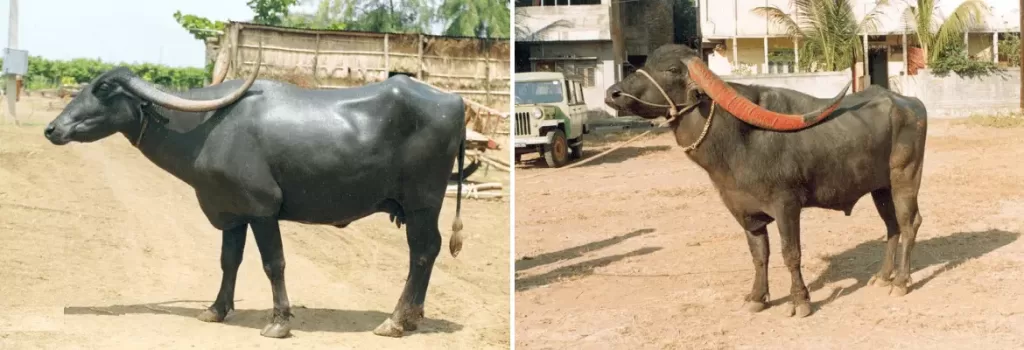
Other names of Pandharpuri buffalo breed : -None-
Pandharpuri buffalo Main Use : Draught, milk
Pandharpuri buffalo Breeding Tract : Maharashtra
Pandharpuri buffalo Visible Characteristics : Pandharpuri buffaloes have a distinctive long horns. this buffalo has a long, straight and very prominent nasal bone.
Pandharpuri buffalo Origin : These are Indian Indigenous buffalo breeds named after Pandharpur town of Solapur district in Maharashtra.
Pandharpuri buffalo Colour : Light or jet black coat colour with occasional white spotting on legs, tail and forehead.
Pandharpuri buffalo Horns Shape and Size : The horns of pandharpuri buffalo are very long, extending beyond the shoulder blade and some times even upto the pin bone. The horns can be catagorized in 3 categories : Toki – Usually bending outward and curving backwards and upwards ; Bharkand – Twisted and curling backwards ; Meti – Flat, bending downwards.
Pandharpuri buffalo Milk yield per lactation(kg) : 1790.6
Surti buffalo
Surti buffalo weighs less than heavy breeds, needs less feed, thrive on stovers and little to no green fodder, and produce milk that contains high amounts of fat and SNF. Because of the low maintanence requirements, its prefered buffalo breed of marginal and small farmers. Gujarat’s breeding tract of this buffalo includes Vadodara, Bharuch, Kheda and Surat.

Other names of Surti buffalo breed : Deccani, Nadiadi, Charotari, Talabda, Gujarati
Surti buffalo Main Use : Milk
Surti buffalo Breeding Tract : Gujarat
Surti buffalo Visible Characteristics : Surti buffalo is a medium sized buffalo. It has a very distinctive set of hite bands running don the neck.
Surti buffalo Origin : These are Indian Indigenous buffalo breeds named after Surat districts of Gujarat.
Surti buffalo Colour : Black or rusty-brown or silver-grey.
Surti buffalo Horns Shape and Size : The horns are medium in size and are flat and shaped like a sickle. The horns bend backwards away from the body and downwards and then rise up ending in a point.
Surti buffalo Milk yield per lactation(kg) : 1667
Toda buffalo
Buffaloes of this breed do well in areas with high rainfall and humidity. Generally, toda buffalo is used for work, socio-cultural events, and religious ceremonies. Grazing is the only food source for calve and adult cattle. 3 weeks after birth, young calves are usually taken out for grazing. Grazing occurs in the vicinity of the hamlet, and they are not allowed to mingle with adults in order to prevent suckling.
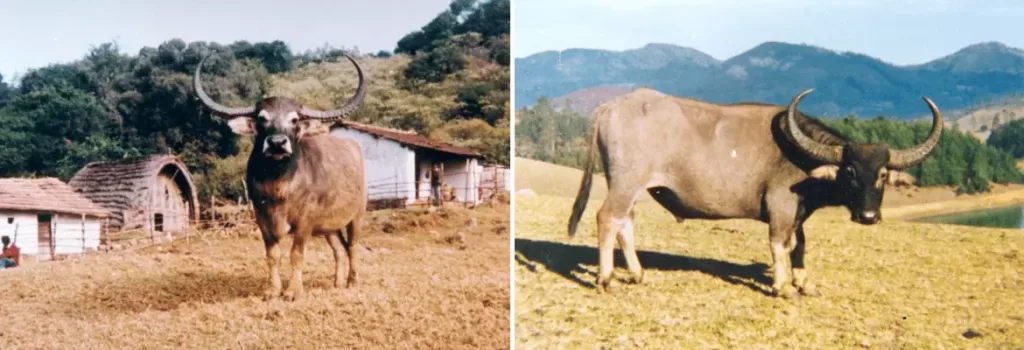
Other names of Toda buffalo breed : -None-
Toda buffalo Main Use : Draught, Socio-cultural
Toda buffalo Breeding Tract : Tamilnadu
Toda buffalo Visible Characteristics : From the point of origin of the tail to the point of the crest of the neck, a narrow band of dense hair covers the top line. There are two chevron markings, one just around the jowl and one anterior to the brisket.le.
Toda buffalo Origin : The toda buffalo derived its name from the toda tribe of Nilgiri region.
Toda buffalo Colour : A calf is usually fawn when it is born. About 2 months after birth, the fawn color changes to ash gray. Among adult buffaloes, fawn and ash-grey are the predominant coat colors.
Toda buffalo Horns Shape and Size : The horns are very thick at the base. The points of the Horns are recurved inward, forming a characteristic cresent shape or semicircle, usually spaced widely apart, outwardly and slightly downward. The average length of toda buffalo horn is 62 cm.
Toda buffalo Milk yield per lactation(kg) : 500

